In the comments posted in the article about the Lane Family and its sons who fought in the First World War, Hazel Meiklejohn, a great-granddaughter of Frank Lane, noted that he had returned to Bottesford after farming in Western Australia and made presentations to groups interested in emigrating Down Under. This article takes a more detailed look at his work to sell the benefits of life on the other side of the planet.
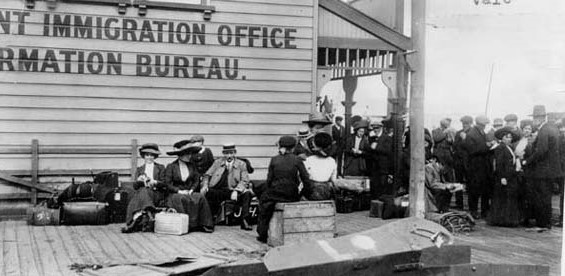
New migrants arriving at Fremantle, Western Australia, early 20th century (Photo – Mrs A H Gurney via WA State Records Office)
Francis Lane was born in Q3.1854 to Marshall Lane and Sarah (nee Billings) and baptised on the 9 January 1855 in Denton. On the 11 December 1879 he married Betsy Robinson in Bottesford. As reported in the main article, Francis took his wife and son to Australia in late 1885, firstly to farm in Queensland. After a couple of years they moved to Northam, 60 miles east of Perth in West Australia.
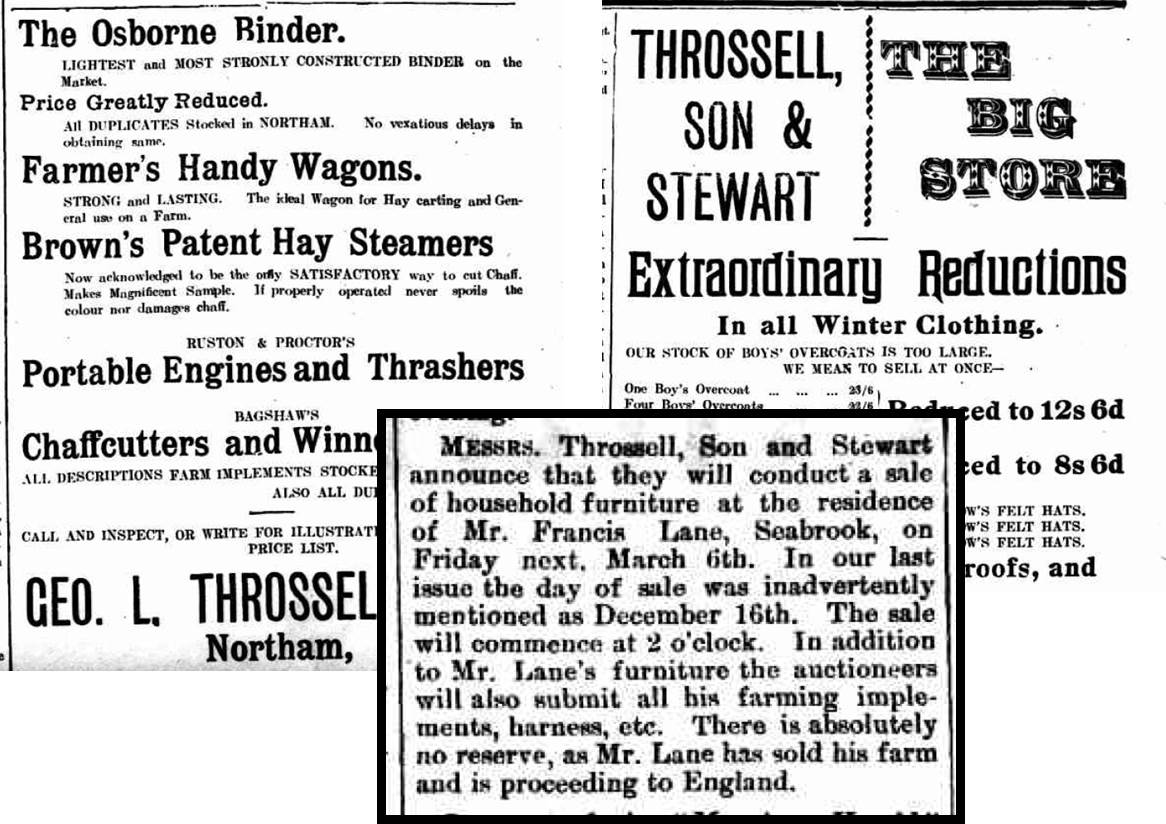
Northam Advertiser 4 March 1903
The Lanes farmed at an area of open grassland called Seabrook, just to the south-east of Northam. During their time there they interacted with neighbours in the community and Frank dealt with nearby businessmen. A notable contact who would reappear later in Frank’s story was George Lionel Throssell, a local merchant who played a large part in local politics and for a short period in 1901 had served as the second Premier of Western Australia. Throssell established several businesses around Northam including the town’s general store, a company dealing in farm machinery and a real estate firm. Hence when the Lanes decided to return to England in early 1903 it was via Throssell, Son & Stewart that they sold their property. (Northam Advertiser 4March1903)
Once back in England they headed straight to Bottesford and Frank rented Devon Farm from the Belvoir Estate. Frank valued his time in Australia and wanted to let others know about the good lifestyle to be enjoyed there.
As early as 1905 he had started to give lectures about his experiences in West Australia. By 1906 he had a lime-light projector and slides to illustrate the talks, giving an impressive presentation style which increasingly suggested he was supported by the Governing Agent of West Australia, though that was not properly the case until later.
A sample of his many presentation dates can be gleaned from newspaper extracts of the time.
(GJ = Grantham Journal; MJ = Melton Journal edition of GJ; NEP = Nottingham Evening Post)
- 24 May 1905 at Orston Primitive Methodist Chapel. Public meeting addressed by F B Lane (sic). At intervals Miss Sherwin, Master Lane and Miss Lane gave pleasing vocal selections. (GJ 3June1905.)
- 17 April 1906 at Bottesford in the National School under the auspices of the Primitive Methodist Society. Lecture by F Lane of Devon Farm, Bottesford, illustrated by lime-light views. (GJ 21Apr1906)
The frequency and scale of lectures increased through the year in 1906 as a drive to recruit new emigrants built momentum. Frank Lane’s region of responsibility seems to be the triangle bounded by Grantham, Leicester and Sheffield, which includes the city of Nottingham. This region was determined by the practicality of the Midland train network that served it.
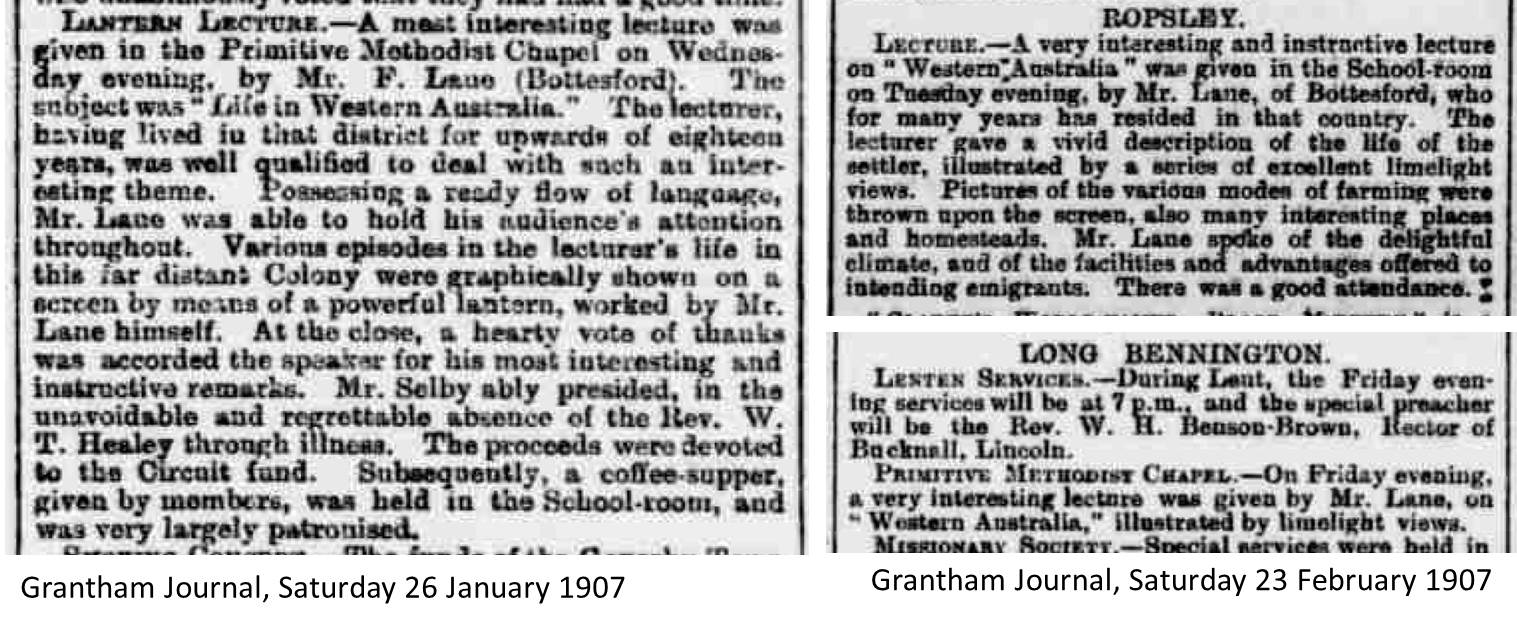
Example reports of Frank Lane’s lectures
- 20 December 1906 at the Liberal Club, Grantham. Lecture by F Lane of Bottesford, with lime-light illustrations. (GJ 22Dec1906)
- 16 January 1907 at the Colles Hall, Melton Mowbray. Lecture by F Lane, again illustrated by slides and stated to be “under the auspices of the Government of Western Australia.” So Frank was claiming a level of authority lay behind his presentation. (MJ 19Jan1907)
- 23 January 1907 at Great Gonerby. A lantern lecture on “Life in Western Australia”, Mr F Lane “possessing a ready flow of language, was able to hold his audience’s attention throughout”. (GJ 26Jan1907)
- 19 February 1907 at the school room, Ropsley. A lecture by Mr Lane illustrated by a series of excellent limelight views. (GJ 23Feb1907)
- 22 February 1907 at the Primitive Methodist Chapel, Long Bennington. Interesting lecture by Mr Lane illustrated by limelight views. (GJ 23Feb1907)
- 25 April 1907 at the school, Bottesford. A lecture illustrated by limelight views by Mr F Lane. (GJ 27Apr1907)
Several of the meetings were accommodated by the Primitive Methodist movement – perhaps it was thought that emigration might appeal more to those from a dissenter background.
By the end of February, Frank’s ideas were sufficiently developed for him to write to his contacts back in Northam to outline his ideas for the settlers he was recruiting. His letter of the 28 February was sent to Messrs Stewart and Ackland, (Stewart being the business partner of George Throssell) saying he hoped to persuade the WA Government to set aside 40,000 acres to form a village settlement, to be populated by a first batch of immigrants plus others to follow later. A few weeks later his group gathered in Nottingham:
- 10 May 1907 at the Mikado Cafe, Nottingham, a meeting at which the representatives of 30 to 40 intending emigrants met with F S Brookman, chief surveyor of West Australia and E T Scammell of the Western Australia Government Agency. The emigrants will leave at the end of May and will be accompanied by Mr F Lane of Bottesford. Mr Brookman laid out the benefits of settling as a group, to be able to share labour and skills and to have a critical mass population that would attract services such as the railway companies. (NEP 10May1907).
Limelight illumination had originally been developed around 1825 to provide an intense light-point for sight-line plotting by the Ordnance Survey. By the early 1900s it was widely used in scientific and theatrical applications and was available in a portable form for slide shows. However, it was still a dangerous technology and susceptible to failures. Electricity would not be readily available as a practical alternative for several years more, especially out in rural villages.
- 22 May 1907 at the old school-room, Stathern, a lecture by Mr F Lane. Unfortunately, owing to the lantern not being in working order, the splendid limelight views illustrating the lecture could not be thrown on the sheet, much to the regret of the fairly attended meeting. (GJ 25May1907)
To present his shows, Frank had to hang a white sheet on a wall of the venue and would lug around a projection device with a limelight source, probably a Drummond Light such as shown here. It involved a mix of oxygen with a fuel of hydrogen, alcohol or ether being burnt in the right ratio, the flame being directed onto a quicklime block (calcium oxide) which would glow brightly.
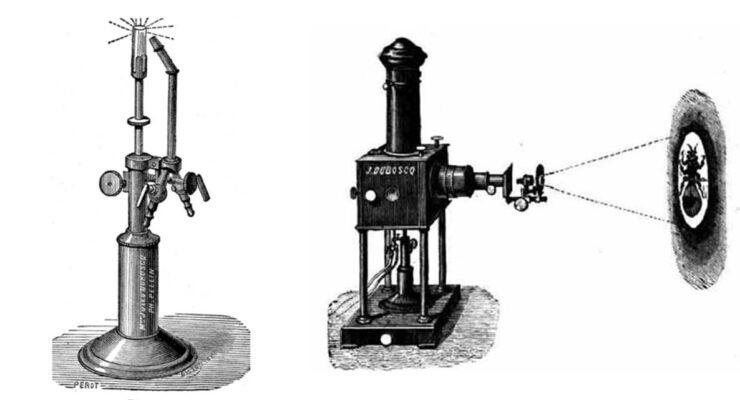
Drummond Lamp and Limelight projection (Image – Bulletin of the Scientific Instrument Society)
- 29 May 1907, an article in the Sheffield Daily Telegraph, confirming that Frank’s remit extended to that city. It describes a party of 40 to 50 young men sailing for Fremantle with Frank on the RMA Omrah to depart from London on the 31 May. Another party had already departed a week previously, so that the group will be around 100 new immigrants.
A small colony had been started in Fremantle around 1829 and, although settlements such as Northam had been founded soon after, the population had not grown much and Frank Lane’s first move there in 1887 had still been akin to pioneering. Voluntary emigration to West Australia (as opposed to the involuntary transportation of convicts) had only gained true momentum when gold was discovered in the region in the 1890s. Then a large influx of prospectors from the eastern side of Australia and from Europe caused significant population growth in an under-developed region, the colonial authorities realising that they needed to address the balance of skills. There needed to be a support network for the miners and prospectors, so the Governors wanted to attract farmers, builders, carpenters, bakers and so forth to create a sustainable community.
Travel to Australia in the mid-1800s had been arduous and risky, taking months to sail around the Cape of Good Hope, so only the very adventurous would elect to go. But the advent of faster steam propulsion, the opening of the Suez Canal route, and financial support and settlement incentives from the six colonies, meant the journey of just 5 or 6 weeks became far more palatable by the 1890s.
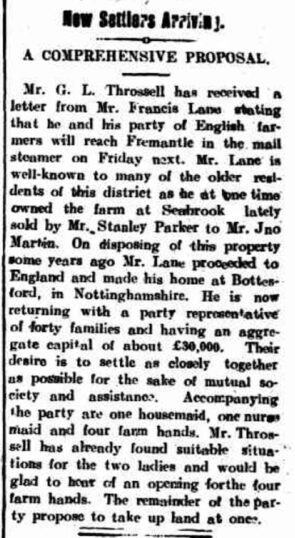
A further spur to increase the growth in settlers from the UK and Europe at the start of the twentieth century was a formal racially motivated immigration policy designed to prevent an influx of Asian – primarily Chinese – people. The “White Australia” policy was enacted by the new Federal Government soon after the six colonies agreed to federate and form the Commonwealth of Australia in 1901. For the previous fifty years the separate colony governments had taken steps to stop Chinese workers from moving in to work as miners, furniture makers and market gardeners. Labour unions also pressed for Pacific islanders to be excluded from Australia to protect white employment in Queensland’s sugar plantations. It would take until the 1970s for the policy to finally be dismantled. By 1907 the race controls were playing right into plans of migration agents such as Frank Lane. Indeed, on the very voyage of the RMS Omrah that carried Frank’s group to Fremantle/Perth, a further 150-plus third class passengers were young British men recruited by another agent, Mrs MacDonald of the Colonial Sugar Company, bound for Brisbane to work in the cane fields of Queensland.
Frank Lane’s party left Tilbury on the 31 May 1907 and arrived in Fremantle on the 4 July. Along the way Frank was able to write and send ahead a letter to his old friend George Throssell to give more details of the mix of talents and skills in the group, reported in the local Northam newspaper (see image on right). In addition to those wanting to buy land, there were a housemaid, a nurse maid and four farm hands seeking employment. By the time they landed Throssell had already found positions for the housemaid and nurse maid.
Frank’s letter to Throssell about the group was quickly picked up by other papers, so their arrival was hot news in the West Australian press and local journalists rushed out to speak to the newcomers even before they had left their ship.
The article about the letter had appeared in the 3 July issue of the Northam Advertiser and the next day a long article in the Perth Daily News explained that a journalist had gone aboard the RMS Omrah at early light to interview Frank. The incoming group comprised mainly young men, representing around 25-30 potential settler families, though seven men had already brought their wives along to stay. In four cases the couples also had their children along: four each in the Holroyd and Boyd families, three in the Knowles family and two in the Winfields. The rain was falling as they looked out across the ship’s rail to the harbour buildings. One young man with a Cockney accent expressed an interest in heading to Kalgoorlie, no doubt with the gold mines in mind, but one of his colleagues who was a member of the Society of Friends advised against searching for such a quick win.
When interviewed, Frank Lane expressed his great pleasure at being back in Australia and noted that the group were nearly all aiming to take up farming. He would be meeting with a Government minister to negotiate concessions but would not go into details until after the meeting had been held. He hoped for several hundred thousand acres to be made available and vouched for the bona fides of the families. They would expect to work hard to clear the land and wanted to settle close together, as a village, to share efforts. Frank also described the growing roster of further families in the UK who he expected to travel out later in the year. It was suggested that the group represented an aggregate investment value coming into West Australia of some £30,000. It was also noted that Frank had himself paid for his costs in bringing the group of immigrants together.
The paper chose to record that the Government Bureau Agent at the port, Mr I Crawcour, computed the total monies brought in by the group and the aggregate ready cash was actually £950. This first group was viewed as an advance guard and that more would follow based on their settlement success. The Government Agent arranged for the group to be lodged at various Perth Coffee Palaces until a final understanding had been reached. Whilst there is no doubt that Frank Lane had been in communication with the Government Immigration Agency before the RMS Omrah set out, there does still sound to be an element of “arriving in hope” about this first expedition.
Several other papers also covered the arrival, including the West Australian.
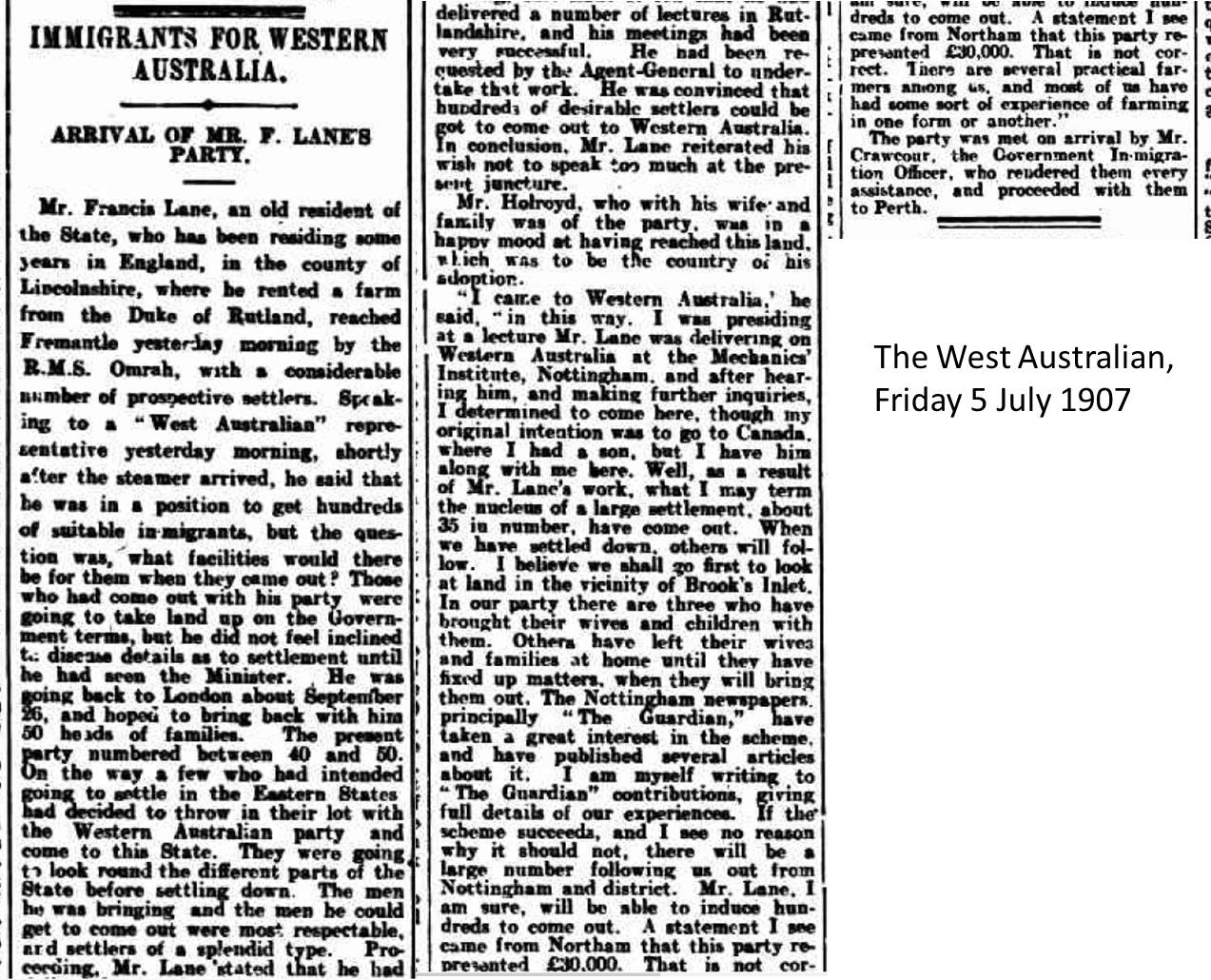
A second article in the Daily News noted the UK press had also taken an interest and one man, James Gordon Holroyd, who had taken his family on the journey, said he would be sending reports back to the Nottingham Daily Guardian so that people back in England could see how the emigrants fared. Holroyd clearly felt committed to the enterprise, with his wife Annie and children Arthur(17), Ethel(12), Norah(11) and Gladys (2) adopting Australia as their new home. Eldest child Arthur already had some experience of long-distance relocation, having tried his hand as a farm worker in Battleford, Saskatchewan, Canada a year previously. The family chose to settle at Dowerin, just east of Perth, where James became postmaster and Arthur took up farming. James died in 1913. His son Arthur lost his life fighting with the Australian Machine Gun Corps in the trenches of France in February 1917, but descendants of the Holroyd daughters still live in Western Australia today.
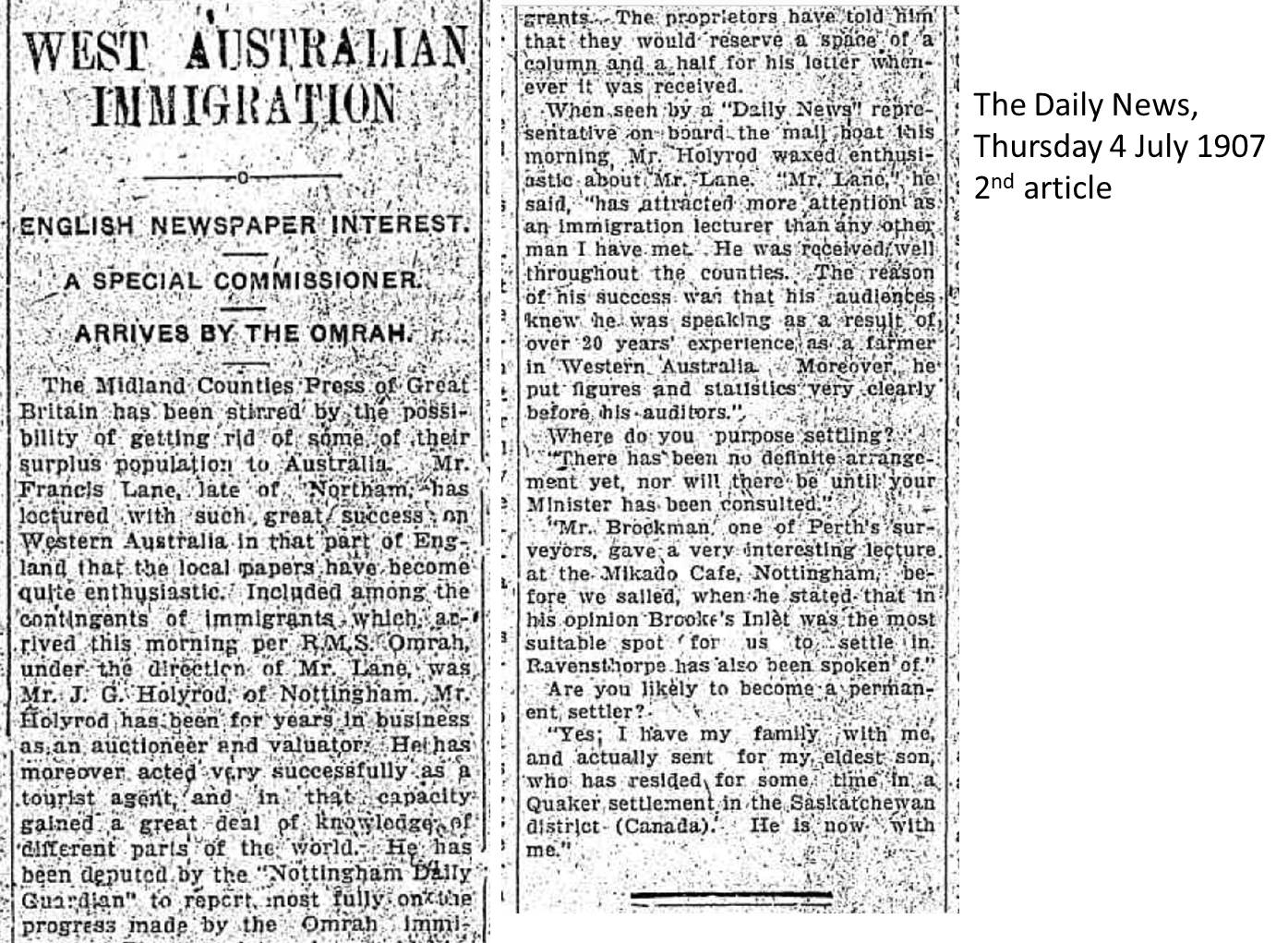
Whilst Frank had his meetings with the authorities in the days soon after their arrival, to discuss possible Government land grants, he sent some men in the group out to various locations to see what other options they might have. Parties went to check on various settlements including Northam, Kalgoorlie, Kojonup, Brooks Inlet, Ravensthorpe and Albany. As is often the case with Government agencies, the release of land was not as fast or coherent as some of the settlers might have wished, but Frank Lane still felt it advantageous for them to take up land offered by the Crown so as to gain the benefit of loans arranged via the Agricultural Bank. Several families opted to make their own deals together during August, no doubt aided by Frank in their purchases. By the end of September 1907 when he returned to Bottesford aboard the RMS Ormuz, Frank was able to tell a reporter from the Morning Herald paper that fourteen families had procured areas around Kojonup and others had distributed across Western Australia. All apparently expressed their satisfaction with the quality of the land chosen. Frank headed for home and at least one further settler group of about fifty souls recruited by him sailed to Fremantle later that year to join those who he had already placed.
The emigrant recruitment programme resumed on his return and Frank extended his catchment area to Lancashire, northern Lincolnshire and East Yorkshire. He even ventured to give lectures in Scotland, totalling around 25 events between his 1907 and 1908 trips. At times Frank found himself in competition with agents working to recruit workers to emigrate to Canada, which Dominion had offered strong financial incentives including paying for ship’s fares and onward travel to the prairie states. Canada had long invested in advertising and at first Frank struggled to match the numbers of signatures won by the North Americans. However, by the time of his later rounds of recruitment from 1908 onward, he claimed that the tables were turned because people in England started to understand the benefit of the warm Australian climate compared to the harsh, hard-to-survive, Canadian winters.
In February 1908 he again set sail on the RMS Omrah for Fremantle with a party of over 100 intending settlers. After the five week voyage he would stay with the new immigrants for two months to help them get established and then return to England. (GJ 29Feb1908)
The Lane family figured prominently in that 1908 issue of the Grantham Journal that reported his imminent departure, with his relatives appearing in the two articles directly below his own report. At a gathering to listen to songs, readings and recitals at the Primitive Methodist Church, Miss F Lane sang “Ora Pro Nobia” and Mr Marshall Lane sang three songs, “Soldier of the Cross”, “The Last Parade”, and “Glory to Thee, my God, this night”. And on the previous Wednesday a farewell supper had been held for the elder Marshall Lane at the Granby Inn by his friends to bid him God Speed on his return to India for his work. The evening involved food, conversations, singing and some toasts, including to Mr Lane and to the Duke of Rutland.
Whereas the arrival of the first group in July 1907 had been somewhat haphazard, with lodgings having to be found at short notice, the authorities in Perth were much more prepared when the March 1908 group arrived. Two comfortable buildings had been set aside for the immigrants in Frank’s scheme, one in Irwin Street reserved for families, couples and women, and one in Hay Street solely for single men. A leader article in the Western Mail in April applauded the formation of the Citizens League of Welcome, an initiative by townspeople to ensure new immigrants received the personal support and enthusiastic acceptance by the community that is a step beyond what officialdom might cover.
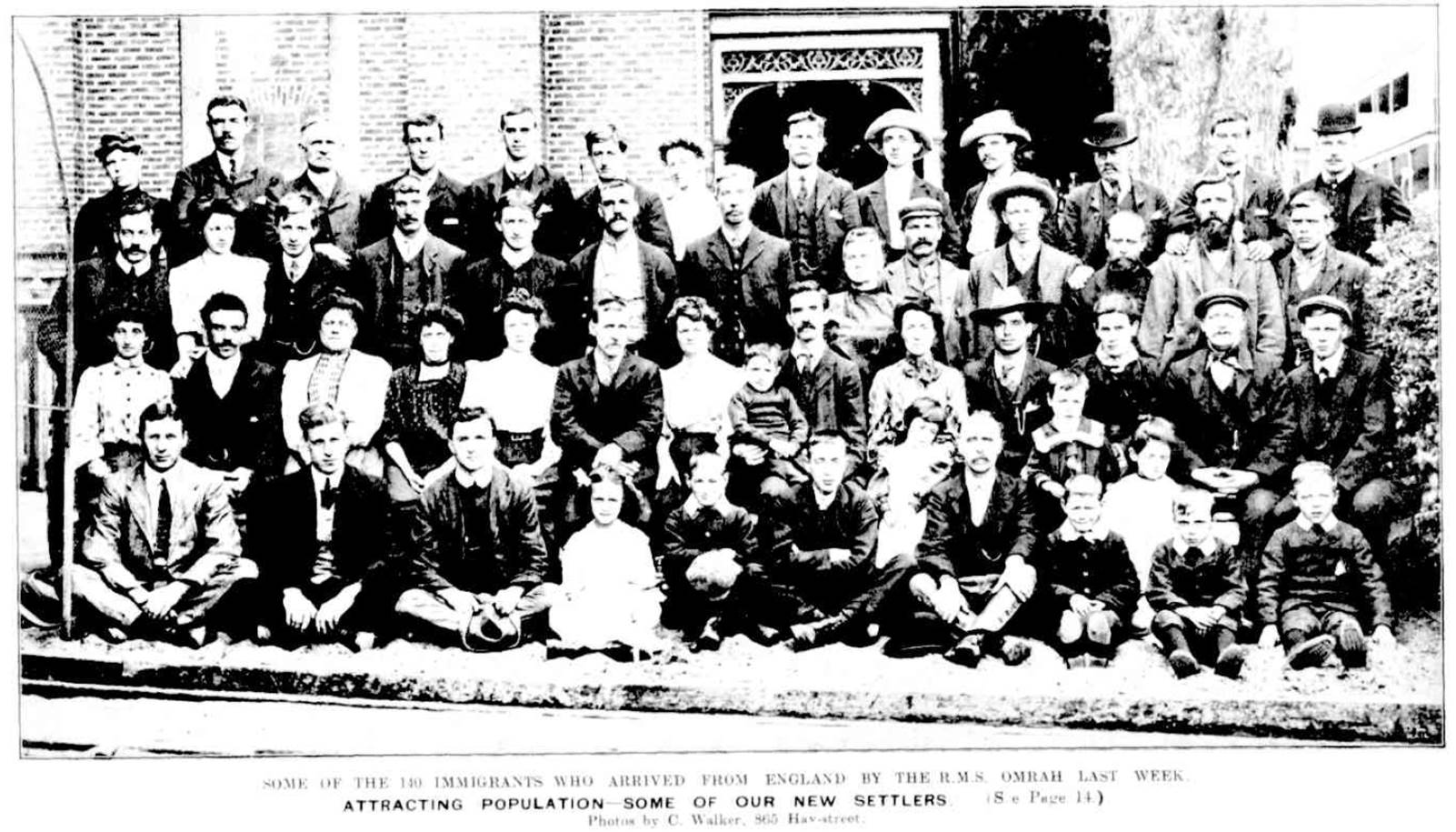
54 of the March 1908 settler group by the Hay Street lodging house. Frank Lane looks to be front row right, by the children. (Photo – Western Mail 4April1908 via Trove)
Reports later suggested that a handful of the Lane settlers gave up and returned to England, but the vast majority stayed in Western Australia and thrived. One apocryphal story considered two brothers, Bill and Bob. Bill returned to the UK complaining that a living could not be made in Westralia, but after reports reached England that Bob had stayed and made a good living, Bill supposedly u-turned again and went back to try again Down Under.
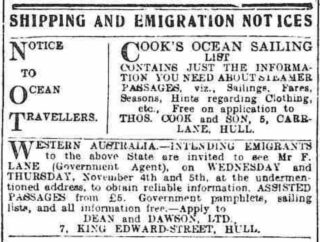
Frank stuck to his plan and, having helped the second group to start to find their new homesteads, sailed home in May 1908. Always thoughtful about how he might capture the attention of potential clients at his lectures he contrived to take a new friend back to Leicestershire on the ship. The villagers of Bottesford were certainly amazed when he took his pet wallaby home to show his friends and neighbours.
Frank’s agency work continued after his second antipodean trip as shown by this advertisement placed in the Hull Daily Mail, 27 October 1908.
As we know from the previous Lane Family article, in 1910 Frank took his wife and children back to West Australia to re-settle there for good, farming around Albany. Once again, Frank took a large party of his recruited immigrants with him, but chose to stay this time and practice the message that he had been preaching. Many of those new Australians recognised that it was thanks to his experience, planning and guidance that their own relocation stories proved successful.
It is delightful that Frank’s descendants are still in contact with the Bottesford community, from where he set out over a century ago.
Update – some images added here relevant to the comments lower down the page:

Frank Lane seeking a refund for a poorly installed furnace (GJ 8 December 1883)
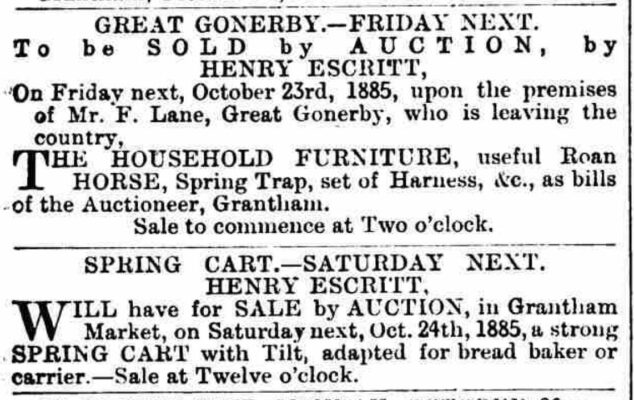
The Lanes’ bakery contents auctioned on 23 October and their delivery van sold the next day. They sailed for Brisbane a month later. (GJ 17 October 1885)
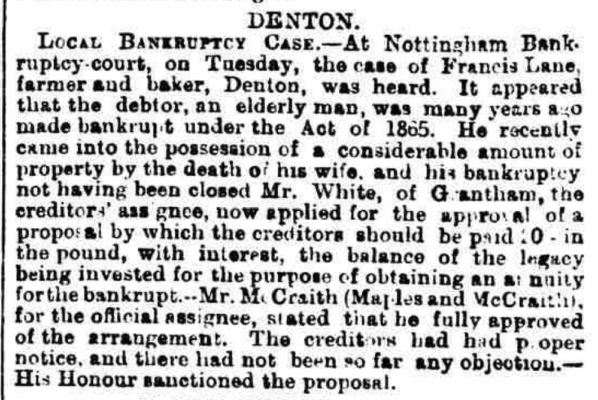 Frank’s uncle Francis reached agreement with his creditors in 1886. He died the next year. (GJ 20 November 1886)
Frank’s uncle Francis reached agreement with his creditors in 1886. He died the next year. (GJ 20 November 1886)
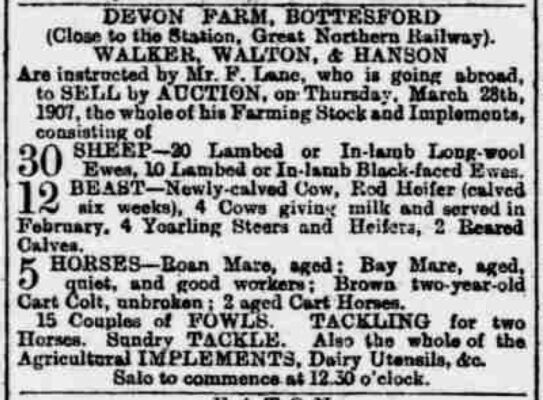
In selling Devon Farm Frank revealed he considered moving back to Australia in 1907. (GJ 23 March 1907)
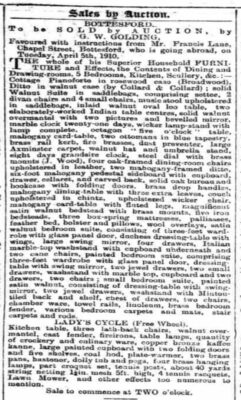
The auction of Frank and Betsy’s belongings ahead of their re-settling in Western Australia in 1910 (GJ 26 March 1910)
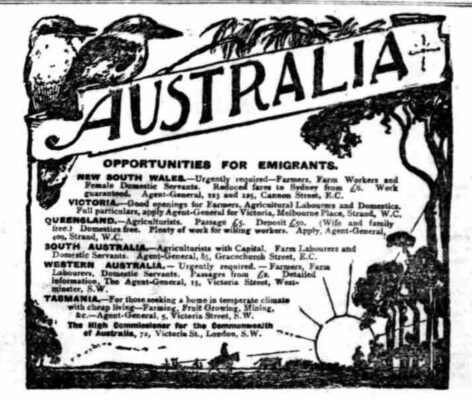
The following references were useful for this article:
Press articles as noted above – thanks to the following sources:
- Find My Past / British Newspaper Archive
- Trove https://trove.nla.gov.au/?adv=y
“Drummond Light, Limelight: a Device of its Time”, Pierre Lauginie, 2015 article in Bulletin of the Scientific Instrument Society issue 127.
State records of Western Australia http://www.sro.wa.gov.au/archive-collection/collection/passenger-lists-and-immigration-records (Header photo thanks to this source)
South Australian Maritime Museum http://passengersinhistory.sa.gov.au/vessel-voyages-all/933083
RMS Omrah – https://trove.nla.gov.au/newspaper/article/71325494 and https://en.wikipedia.org/wiki/SS_Omrah
RMS Ormuz – a great deal of fine research at http://ssmaritime.com/Ormuz-1886-1912.htm









Comments about this page
Hi Bill,
Thanks for putting in all the hours to research and write this first rate article, which adds a great deal about the Lane family and also about the links between Bottesford and Australia. One question that I would like to ask: have you come across lists of the folk from Bottesford and the Vale who were among Frank Lane’s parties of emigrants?
Very best wishes, Neil.
Hi Neil,
Many thanks and that is a very good question, though not straightforward to answer.
I have not seen any specific lists of people from the Vale area who went with Frank to Australia.
I have taken a quick-ish look at the ships’ manifests on Ancestry and FMP and the challenge is that several hundred passengers were on each vessel, with limited details included. For the 1907 and 1908 groups it does at least look like his party are listed together, but for the 1910 voyage the names seem to be all over the place.
I will add a couple of links to the page above with information about the ships that Frank sailed on. 1907: Out on RMS Omrah, back on RMS Ormuz. 1908: out on RMS Omrah, back on TBC. 1910 emigrated on RMS Ormuz.
The 1907 party going out looks to be 44 persons of whom 25 can be seen definitely staying on in WA and it is likely that most of the others did too. The passenger list includes their ages, making quick searches feasible. A few names did return to England afterwards, but at least two of those tried again in Oz later.
It is tricky to judge where the people were living when Frank recruited them as the nearest census was in 1901 which left plenty of time for them to have relocated elsewhere by 1906/7, and electoral rolls are too sparsely available on-line for that time. A couple of single men look to be from Leicester. The Holroyd family were from Nottingham, as were a family of four called Winfield. and a few single men who maybe could have moved to the Vale. There were several from Yorkshire including the Knowles family from Intake near Doncaster.
A sad point to note is that two of the first F Lane group of emigrants did not see out the year of 1907. The family of James Boyd had come from Falkirk, with his wife Agnes, daughters Agnes and Jean and sons James and Francis. The mother Agnes died on the 21 September in Leederville. Perth. The family remained in that area, however, and the daughter Agnes married in 1916, presumably fulfilling the new life that her mother had hoped for them. And a single settler, William Henry Rickatson, from Bedale in Yorkshire, died in Fremantle on the 16 December 1907, cause unknown. He died intestate and local lawyers advertised in the WA press for claims to his £9 5s estate the following spring.
The 1908 manifest did not include people’s ages, which would make them harder to place, but an immigration record at the Fremantle end does give some age data so I will take a look at that in coming days to see if any Vale names are included. 107 people in that 1908 group can be identified travelling from London to Fremantle, though contemporary reports suggest there should be more. Interestingly, Frank did not start with the group, instead joining them when the RMS Omrah docked at Plymouth en route.
All the best, Bill
Hi again Neil
I took a further look around for information about the 1908 Frank Lane group and the searches also uncovered some further interesting details about Frank and his relatives:
– As with the 1907 group it is not possible to trace all of the emigrants who Frank organised in 1908 and none are directly linked to the Vale with any certainty.
– An article in the Grantham Journal stated that his 1907 list comprised people “from Nottingham, Sheffield, Leicester, Melton Mowbray and Loughborough.” Maybe the Melton person(s) was from the Vale side of the town, but I haven’t pinned down who it was. (GJ 1June1907)
– In July 1908 the GJ reported that two families were emigrating to WA from Asfordby, being Mr & Mrs Coulston (he a worker at Holwell Iron Foundry) and Mr & Mrs Exton (a worker on Midland Railway). It is not known if Frank Lane recruited them, but they were not far away. (GJ 20June1908)
Regarding the Lane family history:
– Frank looks to have been named after his father’s eldest half-brother, Francis Lane born in Claypole in 1813 to William Lane and his first wife, Lois (nee Bush), who he had married in 1809 in South Collingham and who died in 1815. William then went on to marry Elizabeth Marshall in 1816 (who I think died in Q1.1847, probably in Claypole but by then the registration district was Grantham), and subsequently remarried to Sarah Ulyatt in 1848 as noted by Sharon Burke in the Lane Family article comments.
– That Francis (i.e. born 1813) was a farmer and licenced victualler in Denton whose first wife died, so he re-married to Elizabeth Sandilands in 1861. She had been the housekeeper at Harlaxton Manor for 16 years. Frank’s uncle Francis was made bankrupt just a year later in 1862 and became a grazier and baker in Denton. When his wife died in 1885 he inherited a sizable amount from her, so his creditors were finally able to make a claim. In it they were granted 10/- in the £1 towards repayment of Francis’ debts and the balance went into an annuity to keep him, as he was by then in his seventies. Uncle Francis died in his sleep in May 1887. (GJ 13March1880; 16May1885; 20Nov1886; 28May1887)
– There seem to be two tribes of the Lane surname around the Great Gonerby/Claypole area, including this William – Marshall – Frank line, which came from Bottesford (and of course Frank returned there for a while); and another line which came from the Bourne district (it also had some Francis Lanes). Perhaps they came from the same roots, but it means it is possible that we get them slightly mixed up – hopefully not.
– It has been noted that Frank Lane was a baker in Spittlegate in the 1881 census. By 1883 he had moved his family north to Great Gonerby, on the other side of Grantham, and set up a new bakery on the village High Street. A previous baker there had gone into liquidation in 1881. It seems that Frank and Betsy were dissatisfied with work done on their new shop, as they took William Selby and his son, also William, to Grantham Crown Court to recover monies spent on goods and a new furnace to be used for making “pyflets”. (GJ 8Dec1883).
– An advertisement showed that the Lanes sold up their business when they emigrated just two years later. The trade in Great Gonerby was clearly not sufficient to sustain a bakery, given that two had tried and closed in just a few years. (GJ 17Oct1885)
– When Frank Lane left for Australia in 1886 he was following the trail of his sister Kezia (as noted by Sharon Burke in comments at the main lane Family article). She had married a J W Robinson and landed at Cooktown in the far north of Queensland on the 3 March 1884. They were two of just thirteen settlers there from the SMS Sirsa which dropped immigrants off at Cooktown (13), Townsville (56), Bowen (28), Mackay (24), Rockhampton (107) and finally 315 at Brisbane. However, as it is known Kezia later settled 2000 km further south, at Tallebudgera which is about 100 km south of Brisbane, and that Frank and Betsy landed at Brisbane, it could be conjectured that JW and Kezia had communicated their experiences and recommendations to Frank and they had, perhaps, already moved nearer to Brisbane when he arrived. (Brisbane Courier 15March1884)
– Newly found articles show that Frank was giving talks about Western Australia in Vale villages as early as 1903, usually at Primitive Methodist Church meetings.
– He was also keen to be generous to village activities while he was at Devon Farm, hosting a badminton club in the barn in 1904 – it was still thriving in 1906 – and letting his fields be used for sports and the local volunteers’ drill meetings. He was often reported performing readings and songs at Bottesford village events. (GJ 24Sep1904)
Perhaps the most interesting new find is an advertisement showing that Frank was considering re-settling in Australia himself when he took his first group of settlers to Fremantle in 1907. At that time he sold Devon Farm as shown in an auction notice. There is also a detailed advertisement for the items that the family sold when they at last re-emigrated in 1910, by which time it seems he lived in Chapel Street.
I will post some of these images at the end of the article above, for reference.
Kind regards, Bill
Hi Bill
This is a great piece of work giving an insight into early emigration to Australia. My mother was born a Holroyd and therefore I have been researching the family for 20 years. This article confirms my own research but also gives new insights into James Gordon Holroyd and Arthur Comport Holroyd which I did not have before. Arthur was my 2nd cousin 3rd removed.
Thanks Vince
Hello Vince
Many thanks. I am so pleased you found the article of use.
Kind regards, Bill
Hi Bill, Thanks for this article on Frank Lane who was my Gt Grandfather. I have learnt a lot through this.
When he first came out to Queensland he had two sons and then went on to have two daughters one being my Grandmother who was called Frances When you said one a Miss Lane giving a vocal selection with her brother and Miss Sherwin that would have been my Grandmother Frances as apparently she had quite a talent for singing.
When they left England again to come back to Australia in 1907 , the second son Lawson stayed on at Bottesford . He was licensee at the Red Lion pub in 1928. When we went to Bottesford a few years ago we met his daughter Freda Dunwell and had time with her daughter Pat who took us around the lovely village.
Keep up the good work and I do hope they are able to maintain the Red Lion Pub as it is history.
Regards
Hazel Meiklejohn
I am pleased you like the article Hazel, especially as it was your comment that set me off on the trail.
regards, Bill
Add a comment about this page